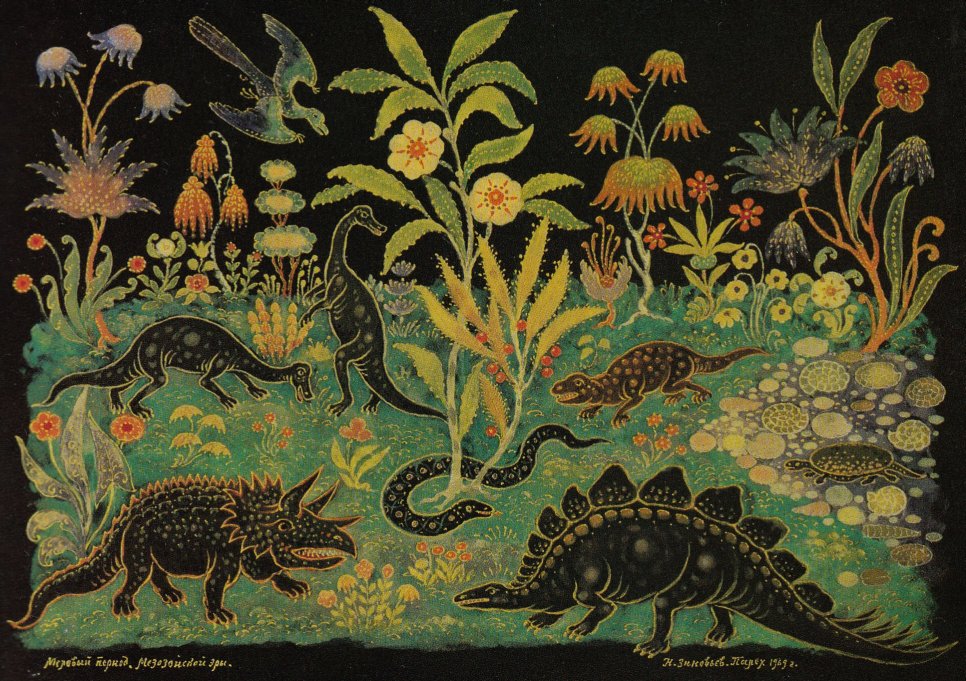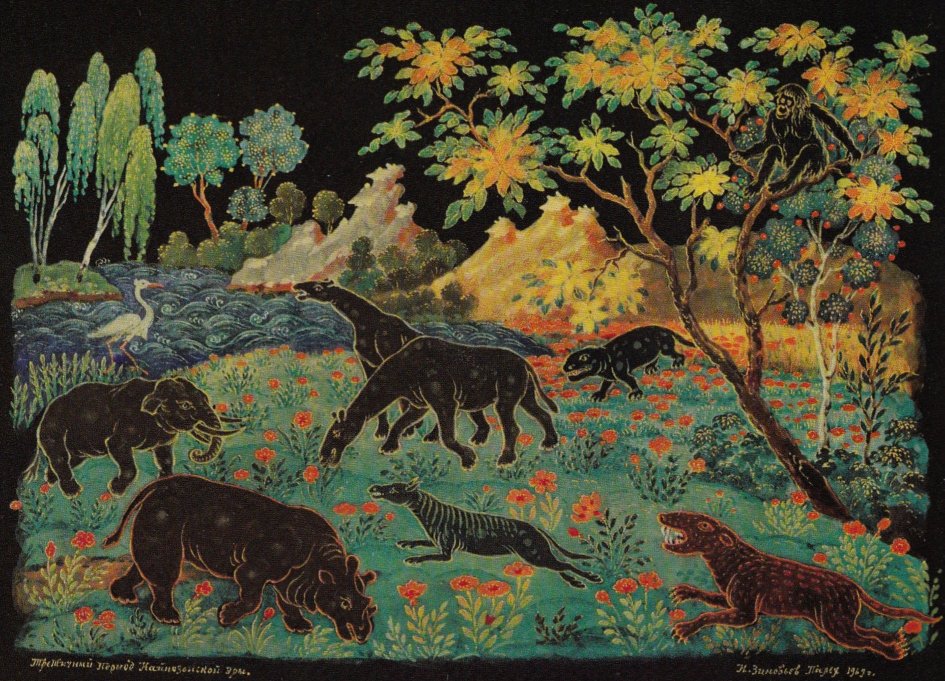1.10: The Rise of Contemporary Ecosystems
- Page ID
- 49655

Cretaceous and Paleogene periods are usually referred to as different eras. However, here we join them in one epoch, as the development of the biosphere between the Cretaceous and the Paleogene did not change its direction.
The climate on Earth at that time was generally favorable for life, at in the end of the Cretaceous period, one of an absolute maximum of temperatures on Earth was observed. Continents gradually acquired current positions and outlines. Alpine orogeny began, then Andes and the Rocky Mountains arose, and then the Himalayas.
The main event of this epoch was the Aptian revolution. At the very end of the Lower Cretaceous almost simultaneously appeared those groups of animals and plants which are dominant to this day: flowering plants, polypod ferns, placental mammals, higher (tailless) birds, social insects (bees, ants and termites), butterflies, and higher bony fishes.
The origin of flowering plants for a long time was considered enigmatic. However, they do not radically differ from the rest of the seed plants: neither double fertilization nor protection of ovaries, much less the presence of a flower are unique attributes of flowering plants.
On the other hand, recent studies of both fossil and modern flowering plants indicate that the first flowering plants were herbaceous perennials, and some of them even aquatic. It is possible that during the previous epochs, some smaller primitive “gymnosperms”, so-called “seed ferns” gradually acquired a herbaceous appearance, together with the capacity for easy vegetative reproduction (“partiality”), and a much shorter and more optimized life cycle. In the same direction, many other groups of seed plants were evolved, pushing each other’s evolution, but the ancestors of flowering plants were the first to achieve this level.
Flowering plants colonized the land quickly, first at herbaceous stories where ferns and mosses could not compete with them (and there were no other seed plants, too). Then secondary woody flowering trees were formed, and apparently, they began to interfere with the woody “gymnosperms”. By the end of the era, angiosperms forced out all other plants (except conifers) on the periphery of the ecosystems. As the climate gradually differentiated (becoming colder in high latitudes and warmer in the lower latitudes), tropical forests arose (they did not exist from the Carboniferous period).
An important event in the middle of the Upper Cretaceous was the occurrence of graminoids (grass-like plants). Capable of firmly retaining captured territory, they began to play an increasing role in communities.
The leaf litter of flowering plants, which is much copious than that of other seed plants (remember their fast life cycle), dramatically changed the carbon regime of freshwater ecosystems. Most of the oligotrophic (as modern sphagnum bogs) places have become mesotrophic or eutrophic, rich in organic substances. This is associated with strong changes in the fauna of insects (the emergence of higher forms of Diptera and beetles), and in turn, associated with the previous event the emergence of numerous insectivorous lizards, as well as with the radiation of tailed amphibians. Another consequence was probably a change of the outflow of some elements to the sea, possibly having an influence on the further development of the marine communities.
In the seas, various crocodiles, hampsosaurs, and giant mosasaur lizards dominated, and then extinct, likely due to the rapid radiation of fast-swimming higher bony fishes. At the end of the era, cetaceans appeared. Cephalopods began to decline, but the role of gastropods and bivalves significantly increased.
Extinction of dinosaurs is usually called the main event of this era. It must be said, however, that many dinosaur groups died out much earlier than the end of the Cretaceous, and many faded gradually, so Cretaceous extinction was only the “last stroke” of their decline.
On the other hand, the often-named exogenous causes of extinction (meteorite, etc.) do not explain why it touched practically only dinosaurs and had little effect on the evolution of the other tetrapods, insects and plants. In most of Earth history, exogenous influences cannot be firmly tied to any evolutionary event, for example, the time of the appearance of the largest meteorite craters of the Phanerozoic cannot be associated with any extinction.
One of the endogenous causes of extinction was the appearance of a predator capable of feeding on small and medium-sized prey (Rautian’s hypothesis). The fact is that before the Cretaceous period, the animals of the small-sized class were represented only by insectivorous forms. However, gradually improving the dental apparatus, some mammals finally switched to plant food. These improvements finally led to the emergence of predatory forms capable of feeding on these herbivorous mammals. (Note that insectivorous animals of small size could not serve as regular food for any predator according to the law of the ecological pyramid.)
Since such a predator (they could be small predatory lizards, snakes, birds, and other mammals that appeared in this era) could not be specialized only in one kind of prey, it was necessarily the main enemy of small offspring of giant dinosaurs.
The other point is that the average size of adult dinosaurs increased dramatically by the end of the Cretaceous (this is the typical race of arms between prey and predator), but young dinosaurs simply could not be large! Dinosaur eggs had an upper limit of size because they (1) must be warmed to the center and also (2) be reasonably easy to hatch.
So small carnivores added much pressure to the gradual extinction of herbivorous, and after them, large predatory dinosaurs. Small dinosaurs evolve into birds, and whoever was left, did not have any significant advantages over mammals and birds, and therefore lost in the competition.
It is curious that the extinction of large predatory forms led to a kind of “vacuum” in terrestrial communities, and the most unexpected groups pretended to be predators before the advent of real predatory mammals (at the end of epoch): there were terrestrial crocodiles, giant predatory birds, and carnivorous ungulates.
Pterosaurs evolved into more and more large forms, and at the end of the era, they were unable to withstand competition with increasingly better flying birds. However, the first flying mammals appeared: bats, whose flight arose, perhaps, as a means to save themselves from tree-ridden predators. Bats and birds safely divided the habitat, which is why they co-exist today.
Winning groups started extensive radiation. In the described epoch, several hundreds of order-level groups of mammals, birds and bony fishes appeared, and the most orders of flowering plants.



